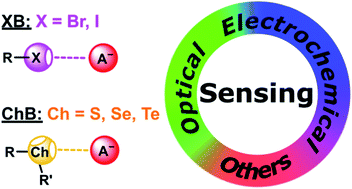Halogen bonding and chalcogen bonding mediated sensing
Abstract
Sigma–hole interactions, in particular halogen bonding (XB) and chalcogen bonding (ChB), have become indispensable tools in supramolecular chemistry, with wide-ranging applications in crystal engineering, catalysis and materials chemistry as well as anion recognition, transport and sensing. The latter has very rapidly developed in recent years and is becoming a mature research area in its own right. This can be attributed to the numerous advantages sigma–hole interactions imbue in sensor design, in particular high degrees of selectivity, sensitivity and the capability for sensing in aqueous media. Herein, we provide the first detailed overview of all developments in the field of XB and ChB mediated sensing, in particular the detection of anions but also neutral (gaseous) Lewis bases. This includes a wide range of optical colorimetric and luminescent sensors as well as an array of electrochemical sensors, most notably redox-active host systems. In addition, we discuss a range of other sensor designs, including capacitive sensors and chemiresistors, and provide a detailed overview and outlook for future fundamental developments in the field. Importantly the sensing concepts and methodologies described herein for the XB and ChB mediated sensing of anions, are generically applicable for the development of supramolecular receptors and sensors in general, including those for cations and neutral molecules employing a wide array of non-covalent interactions. As such we believe this review to be a useful guide to both the supramolecular and general chemistry community with interests in the fields of host–guest recognition and small molecule sensing. Moreover, we also highlight the need for a broader integration of supramolecular chemistry, analytical chemistry, synthetic chemistry and materials science in the development of the next generation of potent sensors.

- This article is part of the themed collections: Celebrating five years of ChemRxiv, 2022 Chemical Science HOT Article Collection and 2022 Chemical Science Perspective & Review Collection


 Please wait while we load your content...
Please wait while we load your content...